Recently, the research team led by Professor Li Guoqiang at Lanzhou University published a study on the temporal and spatial variation characteristics of the dating age and main physical properties parameters of Asian loess deposits in the internationally renowned geoscience journal npj Climate and Atmospheric Science (Nature's子journal, Earth Science section 1, IF=10.2).
The climate change in Asia is jointly influenced by different climate systems of westerlies and monsoons, with significant regional differences and complex temporal and spatial evolution. The Asian loess deposits serve as an important carrier for revealing the laws of past climate change. The luminescence dating is the main technical means for dating loess, and the analysis of proxy indicators of the ancient environment is the basis for reconstructing past climate changes recorded in loess deposits. Firstly, researchers standardized the luminescence dating data and proxy indicators of the ancient environment produced by more than ten research teams at home and abroad, and constructed a dataset of luminescence dating and proxy indicators of the ancient climate for Asian loess. The dataset includes 2800 luminescence dating data of 128 loess-paleosol sedimentary sequences spanning Iran's northwest to China's northeast, as well as original calculation parameters, and 33,000 paleoenvironment proxy indicators such as particle size. Based on this dataset, the Asian loess distribution area was divided into six sub-regions: West Asia, Central Asia, the Qinghai-Tibet Plateau, the Loess Plateau, Shandong Peninsula, and Northeast China Plain (Figure 1). The researchers systematically analyzed the variation characteristics of luminescence ages and radioactive elements such as uranium, thorium, potassium, rubidium, water content, and dose rate for quartz and potassium feldspar in different regions. They also clarified the temporal and spatial variation characteristics of the main physical properties parameters such as particle size, magnetic susceptibility, and color intensity in different regions (Figure 2). This study provides basic parameter data for analyzing the main physical properties of Asian loess. It can also provide data support for analyzing the formation times, deposition processes and mechanisms of loess-paleosol sequences, as well as reconstructing westerly and monsoonal climate changes in different time scales in the past. Therefore, it is of great significance for studying ancient climate changes in Asia. The dataset constructed in this study is the most detailed dataset of luminescence dating and proxy indicators of the ancient climate for Asian loess that has been published so far. The dataset can be downloaded free of charge from the Qinghai-Tibet Plateau Data Center (https://data.tpdc.ac.cn/zh-hans/data/d478815c-2192-4cc3-8036-62f03e9ec1ec).
Professor Li Guoqiang is the first author and corresponding author of the research paper. Lanzhou University is the first completing unit. Academician Chen Fahou from the Institute of Qinghai-Tibet Plateau of the Chinese Academy of Sciences and Professor Kathryn E. Fitzsimmons from the Max Planck Institute for Chemistry are co-corresponding authors. Dr. Song Yougui from the Institute of Earth Environment, Chinese Academy of Sciences, Dr. Kang Shugang from the Institute of Earth Environment, Chinese Academy of Sciences, Dr. Yi Shuangwen from Nanjing University, Dr. Zhang Xiaojian from Nanjing University, Professor E Chongyi from Qinghai Normal University, Professor Lai Zhongping from汕头大学Shantou University), Associate Professor Liu Xiangjun from Jiaoying College, Dr. Wang Yixuan from the Qinghai Salt Lake Institute of the Chinese Academy of Sciences, Dr. Ling Zhiyong from the Qinghai Salt Lake Institute of the Chinese Academy of Sciences, Dr. Zhao Qiuyue from Taishan College, Dr. Chen Chunzhu from Nantong University, Dr. Yang He from Chengdu Information Engineering University, Associate Professor Jan-Pieter Buylaert from Aarhus University in Denmark, Associate Professor Thomas Stevens from Uppsala University in Sweden, Dr. Aditi Dave from Babes-Bolyai University in Romania and more than a dozen scholars from a dozen domestic and foreign institutions participated in this study. This research was supported by the Outstanding Youth Support Program of Lanzhou University (Project No. : lucky-2021-ey22), the National Natural Science Foundation of China (Project No. : 42071101), and the Outstanding Member project of Youth Promotion Association of Chinese Academy of Sciences (Project No. : Y2022102).

Figure 1. Distribution of study sites of loess paleosol sequence in Asia

Figure 2. Luminescence age and mean particle size variation of loess sediments in different regions of Asia
Article information: Li, Guoqiang*, Yan, Zhongfeng, Song, Yougui*, Fitzsimmons, Kathryn E*, Yi, Shuangwen*, Kang, Shugang*, E, Chongyi*, Stevens, Thomas*, Lai, Zhongping*, Dave, Aditi K*, Chen, Chunzhu*, Deng, Yanqing*, Yang, He*, Wang, Leibin, Zhang, Xiaojian, Qin, Caixin, Zhao, Qiuyue, Buylaert, Jan-Pieter, Lu, Tao, Wang, Yixuan, Liu, Xiangjun, Ling, Zhiyong, Chang, Qiufang, Wei, Haitao, Wang, Xiaoyan, Chen, Fahu*, 2024. A comprehensive dataset of luminescence chronologies and environmental proxy indices of loess-paleosol deposits across Asia.npj Climate and Atmospheric Science,npj Climate and Atmospheric Science, 7:7;https://doi.org/10.1038/s41612-023-00555-4

Article download link:https://www.nature.com/articles/s41612-023-00555-4.pdf